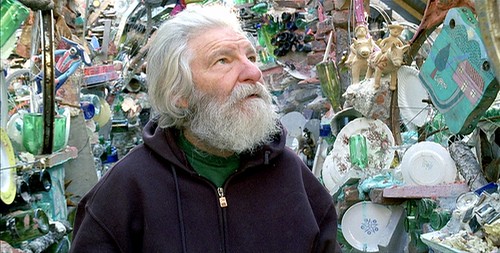
Since most South Street novices are initially enamored with the massive mosaic display of broken bicycle wheels and beer bottles, it’s no secret they eventually question its wacky origins. Frequenters and novices alike are unaware of the origins of painted tiles and seemingly random rubbish affixed to nearly 50,000 square feet divided into more than 100 murals that become a canvas of sorts on the South Street strip.
In A Dream, a film produced by Jeremiah Zagar, is bent on clearing up the ambiguity.
“My father’s pretty famous already,” said Zagar, who is the son of Isaiah Zagar, “so maybe he’ll be even more famous.”
Now playing at the Ritz at the Bourse, In A Dream is a lyrical documentary that chronicles the lives of Zagar’s father and mother as artists during the 1960s. The film depicts how the entire family unit and the surreal, iconic artwork of his father were emblazoned on edifices in South Philadelphia.
“We wanted to combine the real and the surreal,” Zagar said of the documentary. “The real is the work, and the surreal is the slow-motion, animation and the film.”
Narrated by Julia Zagar, Isaiah’s wife, In A Dream is a love story about the strength of family and is told in three parts. One of the three parts is titled “Part II: The End of an Era.”
“That era is the belief that family is stronger than everything else in the world,” Zagar said. “It’s an era of familial perfection. The end of that era is that families are not always strong. They are living in a dream, and the end of the era is the end of that dream and the beginning of a reality.”
The reality is that despite an idyllic childhood as described by Zagar, he and his brother Ezekiel’s upbringings were anything but conventional.
“My father is very attentive but kind of nutty,” he said. “You would go to an art opening, and he’d be naked and covered in mud. It was awkward because I was 5 years old, and all I wanted was my friends to think I was good at soccer.”
Growing up in a castle of shattered glass with a surreal family history, Zagar describes his childhood simply as “cool.”
“I lived in a house people thought was cool, so we’d invite them over and make them pasta, and they thought we were rad,” Zagar said.
“I always loved the basement in my house because it’s circular,” he said. “It’s small, and it’s completely mosaic from floor to ceiling, so you can see all the way around. It’s total immersion in the work – a glittered cavern.”
As a child, the cinema was Zagar’s sanctuary.
“I wasn’t the most handsome kid,” Zagar said. “I was a little chubby and a little awkward, and I just loved the movies. Movies were the dreams that other people dream.”
After years of watching dreams of other people, Isaiah’s very own dream, showcased throughout South Philadelphia, turned out to be the inspiration for a poetic verite narrative.
In A Dream, essentially a life labor, was seven years in the making, after Julia encouraged Zagar to begin filming his father.
“My father is a product of Philadelphia, and he’s quite the performer, so the first footage I got was not very good,” Zagar said.
When he first began capturing footage, Zagar said his father grew closer to him outside of the city.
“I took him to the country, and when he was isolated from the comforts of home, he became much more intimate,” he said.
Zagar said the five days in the country were incredibly difficult, as his father told him a story about being molested as a child, his love for his wife and his battle with balancing art and his presumed madness.
“I knew our relationship had changed from father and son to subject and filmmaker and that I had some incredible footage,” Zagar said.
Zagar said the footage obtained in the country was a chronicle of the memories that built a person — his father.
At first glance, Isaiah’s work appears only as shattered glass and Philadelphia debris crafted into a pastel paradise. But look closely, and it becomes clear that his work documents the life, profanity and sexuality of his life.
Zagar said it is because his father sees everything — even his own feces — as beautiful.
“The scene says you can take this dream too far,” Zagar said. “Playing with your poop is unhygienic, regardless of whether it’s beautiful or not. There’s a certain craziness to someone who wants s–t in his hand.”
Zagar said his father had the tendency to go over the edge.
“I think everything he does is a little bit over the line,” he said, “which is part of what makes it so great.”
Refreshingly obscure and appropriately surreal at times, it is the stunning cinematography interspersed with 8 mm film and Super 16 mm footage of his father and mother from the 1960s that makes the documentary a loving representation of an arts-driven family.
Zagar’s years of cinematic appreciation paid off visually.
“We shot the movie on 35 mm film, but most documentaries are digital,” Zagar said. “Film is silver – big, giant blocks of silver. It’s a true reflection of what we see in light and shadow, and it gives you this feeling of the surreal world.”
The vintage footage of his father and mother was easily obtained, since Isaiah compiled massive amounts of footage. As prominent artists and owners of Eyes Gallery, the couple was involved in the South Street corridor’s 1960s hippie movement.
“People were documenting my parents from back then,” Zagar said. “We had about 30 hours of archival footage, and we tried to use all of it that we could…because the movie is very much a mosaic itself.”
Gabrielle DiPietro can be reached at gdipietro@temple.edu.



Be the first to comment